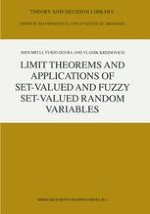After the pioneering works by Robbins {1944, 1945) and Choquet (1955), the notation of a set-valued random variable (called a random closed set in literatures) was systematically introduced by Kendall {1974) and Matheron {1975). It is well known that the theory of set-valued random variables is a natural extension of that of general real-valued random variables or random vectors. However, owing to the topological structure of the space of closed sets and special features of set-theoretic operations ( cf. Beer [27]), set-valued random variables have many special properties. This gives new meanings for the classical probability theory. As a result of the development in this area in the past more than 30 years, the theory of set-valued random variables with many applications has become one of new and active branches in probability theory. In practice also, we are often faced with random experiments whose outcomes are not numbers but are expressed in inexact linguistic terms.
